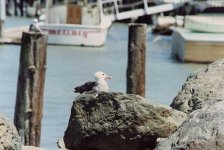digi-birder
Well-known member
Discussing holidays to the USA with our neighbour last night resulted in getting out our photo album from a previous trip, as you do! Looking through it I came across this gull taken by Keith in 35mm days (1990). I then proceeded to ID it using the Sibley Guide, failing miserably.
The month was June and the location is Sausalito, California.
I tried cropping it closer, but the quality was too poor to make the features stand out.
Hope someone can help. It's driving me mad!
The month was June and the location is Sausalito, California.
I tried cropping it closer, but the quality was too poor to make the features stand out.
Hope someone can help. It's driving me mad!





